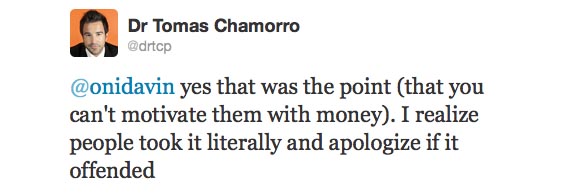

Seven Rules For Pissing Off Artists

Last week, comment sections across the creative community were set ablaze by the Harvard Business Review’s article “Seven Rules for Managing Creative People”, a list of instructions that described the general personality of creative employees with such choice words as “arrogant,” “bipolar” and “psychopathic.”
The article inspired so much vitriol from the online creative community that HBR has since changed its title to “Seven Rules For Managing Creative-But-Difficult People,” clarifying that, “Its intent is to discuss a small subset of people who happen to be both creative and difficult to work with; not to imply that all creative people are difficult.”
For those managers out there too busy corralling their unruly ‘creatives’ to read the entire piece, here are the original 7 rules in a nutshell (if you are a creative, please avert your eyes):
- Spoil them and let them fail
- Surround them by semi-boring people
- Only involve them in meaningful work
- Don’t pressure them
- Pay them Poorly
- Surprise Them
- Make them feel important
 Along with updating the article title, HBR has also amended what is arguably the most egregious of the rules to: “#5. Don’t Overpay Them,” which seems especially scandalous considering the amount of creative individuals working through freelance and contract positions without benefits and health insurance. The author of the piece (pictured left), Dr. Tomas Chamorro-Premuzic (@DrTCP) has also attempted to elaborate on this subject via Twitter:
Along with updating the article title, HBR has also amended what is arguably the most egregious of the rules to: “#5. Don’t Overpay Them,” which seems especially scandalous considering the amount of creative individuals working through freelance and contract positions without benefits and health insurance. The author of the piece (pictured left), Dr. Tomas Chamorro-Premuzic (@DrTCP) has also attempted to elaborate on this subject via Twitter:  Save for a few tweets like the one above and one that states “…it represents my professional opinion, which is informed by science and practice,” Dr. Chamorro has, perhaps wisely, said little about the article since it was published. Cartoon Brew reached out to him for comment, but at the time of this writing, he had not responded to our interview requests.
Save for a few tweets like the one above and one that states “…it represents my professional opinion, which is informed by science and practice,” Dr. Chamorro has, perhaps wisely, said little about the article since it was published. Cartoon Brew reached out to him for comment, but at the time of this writing, he had not responded to our interview requests.
The rest of the Internet has been anything but silent though, and there have been a multitude of responses to the article that raise some well thought out conclusions for the disenfranchised creative individual.
For those seeking to maintain the “us” vs. “them” divide, there’s Lancer Creative Services eye-for-an-eye response, “Seven Rules or Putting up with Management”, which includes advice like “Accept that they don’t get us” and “Remember that Money is everything to them”.
Stevie Moore of Studiospectre takes a more empowered stance, seeing the mere knowledge of the directives as just another tool in the creative professional’s arsenal:
“I think this is a good example of how, of the internet and social networking’s double edge can actually work in our favor. By publishing that, the author is just arming us with knowledge and evidence to ensure a future where creatives have equal roles in the industry, which I dare say all of us here feel is best.”
Cennydd Bowles of AListApart.com finds a more egalitarian view that benefits more than just “creatives” and “non-creatives”:
“The premise that underpins this and many similar articles is that creativity is a binary property: some people are blessed (or cursed) with it, others aren’t…Thankfully, the premise is flawed. Creativity is not a binary ability but a muscle that needs exercise… everyone has creative capacity.”
And indie filmmaker David O’Reilly, who recently directed an episode of Adventure Time, provides a painfully succinct response to the entire editorial debacle, aimed directly at the author himself: 
However, there are still a couple of fundamental questions getting buried beneath all of the hurt feelings and defensive misunderstandings that make up a lion’s share of the response. Questions like: In today’s professional landscape, what defines a “creative”? And where exactly would these suggestions even be considered by management as viable options rather than ignored for potential risks to the bottom line?
(Typical artist photo via Shutterstock)

.png)